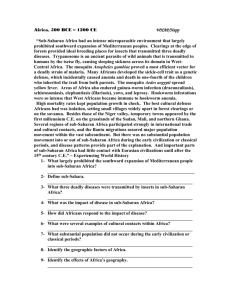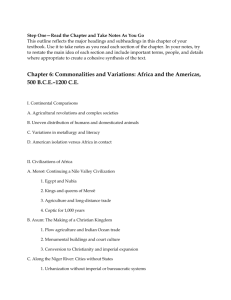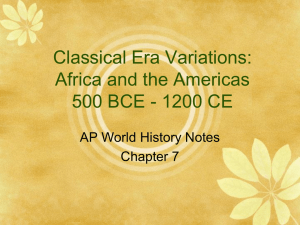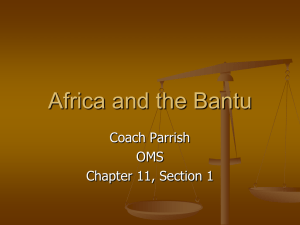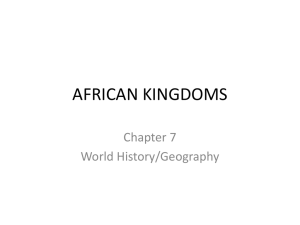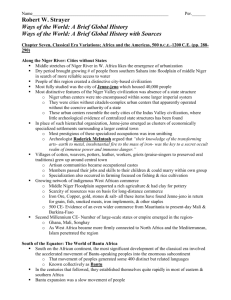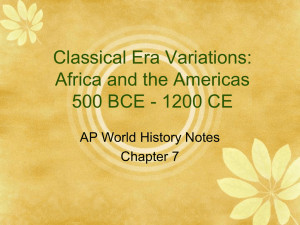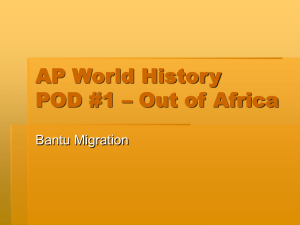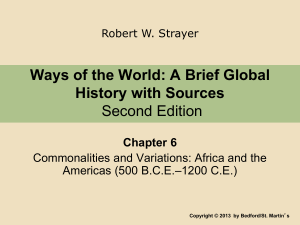Africa, 500 BCE – 1200 CE WHAP/Napp Do Now: “The Bantu most
advertisement
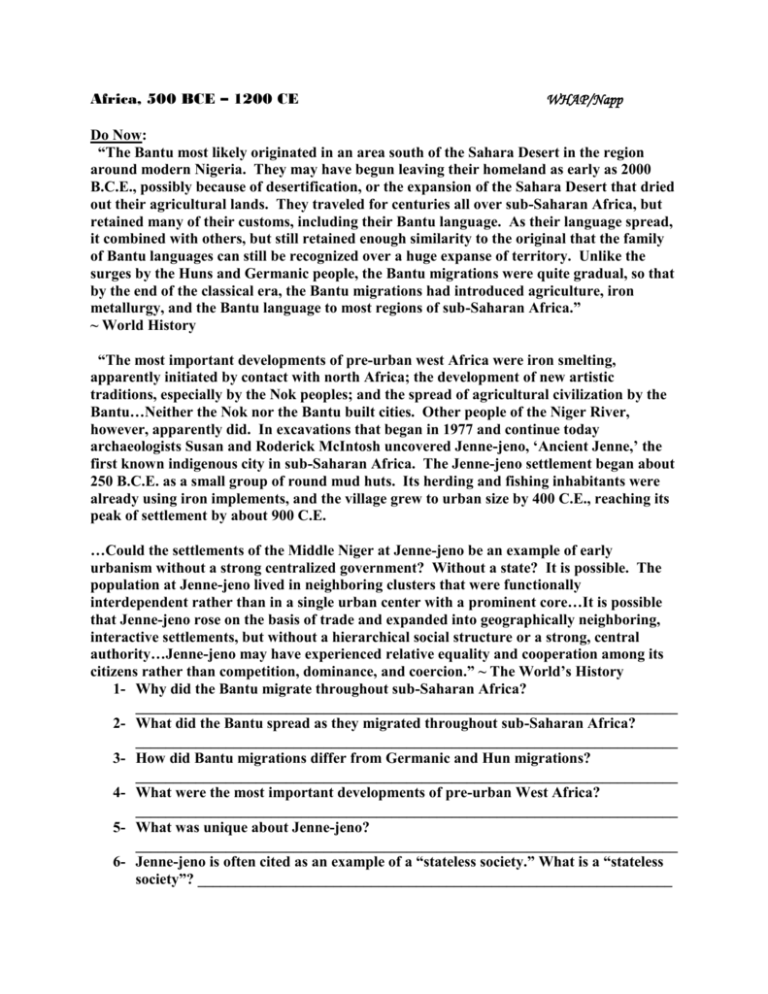
Africa, 500 BCE – 1200 CE WHAP/Napp Do Now: “The Bantu most likely originated in an area south of the Sahara Desert in the region around modern Nigeria. They may have begun leaving their homeland as early as 2000 B.C.E., possibly because of desertification, or the expansion of the Sahara Desert that dried out their agricultural lands. They traveled for centuries all over sub-Saharan Africa, but retained many of their customs, including their Bantu language. As their language spread, it combined with others, but still retained enough similarity to the original that the family of Bantu languages can still be recognized over a huge expanse of territory. Unlike the surges by the Huns and Germanic people, the Bantu migrations were quite gradual, so that by the end of the classical era, the Bantu migrations had introduced agriculture, iron metallurgy, and the Bantu language to most regions of sub-Saharan Africa.” ~ World History “The most important developments of pre-urban west Africa were iron smelting, apparently initiated by contact with north Africa; the development of new artistic traditions, especially by the Nok peoples; and the spread of agricultural civilization by the Bantu…Neither the Nok nor the Bantu built cities. Other people of the Niger River, however, apparently did. In excavations that began in 1977 and continue today archaeologists Susan and Roderick McIntosh uncovered Jenne-jeno, ‘Ancient Jenne,’ the first known indigenous city in sub-Saharan Africa. The Jenne-jeno settlement began about 250 B.C.E. as a small group of round mud huts. Its herding and fishing inhabitants were already using iron implements, and the village grew to urban size by 400 C.E., reaching its peak of settlement by about 900 C.E. …Could the settlements of the Middle Niger at Jenne-jeno be an example of early urbanism without a strong centralized government? Without a state? It is possible. The population at Jenne-jeno lived in neighboring clusters that were functionally interdependent rather than in a single urban center with a prominent core…It is possible that Jenne-jeno rose on the basis of trade and expanded into geographically neighboring, interactive settlements, but without a hierarchical social structure or a strong, central authority…Jenne-jeno may have experienced relative equality and cooperation among its citizens rather than competition, dominance, and coercion.” ~ The World’s History 1- Why did the Bantu migrate throughout sub-Saharan Africa? ________________________________________________________________________ 2- What did the Bantu spread as they migrated throughout sub-Saharan Africa? ________________________________________________________________________ 3- How did Bantu migrations differ from Germanic and Hun migrations? ________________________________________________________________________ 4- What were the most important developments of pre-urban West Africa? ________________________________________________________________________ 5- What was unique about Jenne-jeno? ________________________________________________________________________ 6- Jenne-jeno is often cited as an example of a “stateless society.” What is a “stateless society”? _______________________________________________________________ I. Geographical Diversity A. Deserts, savannas or grasslands, tropical rain forest in center, highlands and mountains in eastern Africa and Mediterranean climate in north/south extremes B. Diverse geographic factors ensured variation and difference among cultures C. But proximity to Eurasia 1. North Africa was incorporated into the Roman Empire 2. Christianity spread Saint Augustine (354-430 CE)African, theologian D. Proximity to Arabiaanother point of contact 1. Arrival of camelTrans-Saharan Trade 2. Also East African coast Part of Indian Ocean Trade Network II. Meroë A. South of Egypt lay Nubian civilization contact, trade, selective borrowing B. Nubian civilization came to center on the southern city of Meroë C. Flourished between 300 BCE and 100 CE D. Governed by an all-powerful and sacred monarch, sometimes a woman E. Smelting of iron and the manufacture of iron tools and weapons D. Rainfall-based agriculture was possible; Extensive trade E. Following 100 CE, declined in part due to deforestation caused by the need for wood III. Axum A. Lay in the Horn of Africa, in what is now Eritrea and northern Ethiopia B. Plow-based farming, unlike most of Africa, which relied on the hoe or digging stick C. Wheat, barley, millet, and teff, a highly nutritious grain unique to region D. Participation in the Red Sea and Indian Ocean commerce 1. Adulis largest port on the East African coast E. Taxes on trade provided a major source of revenue F. Interior capital city, also known as Axum, center of monumental building 1. Huge stone obelisks, which most likely marked royal graves G. Language of court and commerce was Geez [script derived from Arabia] H. Axum was introduced to Christianity in the fourth century CE I. King Ezana, adopted Christianity about the same time as Constantine 1. Like Egypt [Coptic Christianity] – but stronger presence in Ethiopia today J. Sixth century CE, Axum mounted a campaign of imperial expansion K. Next several centuriesdecline due to soil exhaustion, deforestation, etc. IV. Around the Niger River 1. West Africa City of Jenne-jeno [apparent absence of a state structure] V. The Bantu A. Most significant development of the classical era in Africa involved the accelerating movement of the Bantu-speaking peoples into the subcontinent B. Homeland region in what is now southeastern Nigeria and the Cameroons C. Migration generated some 400 distinct but related languages, known as Bantu D. Slow movement that brought Africa south of the equator a measure of cultural and linguistic commonality, marking it as a distinct region E. Farming largely replaced foraging F. Iron was spread during the Bantu migrations G. Also spread banana cultivation [from Southeast Asia through Indian Ocean Trade] 1- Identify two significant geographic features of the African continent. ________________________________________________________________________ 2- Why did diverse geographic features ensure cultural variation in Africa? ________________________________________________________________________ 3- Even though Africa lacked many candidates for animal domestication, domesticated animals existed in Africa. How did Africans receive domesticated animals? ________________________________________________________________________ 4- What do historians mean when they refer to “sub-Saharan” Africa? ________________________________________________________________________ 5- Why did sub-Saharan African cultures differ from North African cultures? ________________________________________________________________________ 6- How did the introduction of the camel change African history? ________________________________________________________________________ 7- Identify the trading partners of East Africans in Indian Ocean Trade. ________________________________________________________________________ 8- Identify three significant facts about Meroë. ________________________________________________________________________ 9- Define patriarchy [Previous Knowledge]. ________________________________________________________________________ 10- In Axum, the plow was used in agriculture. However, in most of Africa, the hoe or digging stick was used. In cultures where the hoe or digging stick was used, women were valued and although considered inferior to men had higher status than women in plow-based agriculture. Why? ________________________________________________________________________ 11- What is teff? ________________________________________________________________________ 12- Why was Adulis significant? ________________________________________________________________________ 13- Why were huge stone obelisks erected in Axum? ________________________________________________________________________ 14- What is Geez? ________________________________________________________________________ 15- Why was King Ezana significant? ________________________________________________________________________ 16- How did environmental factors affect the decline of Meroë and Axum? ________________________________________________________________________ 17- What was unique about Jenne-Jeno? ________________________________________________________________________ 18- Who were the Bantu? ________________________________________________________________________ 19- Why did the Bantu migrate? ________________________________________________________________________ 20- What did the Bantu spread as they migrated? ________________________________________________________________________ 21- How did the Bantu migration ensure a measure of cultural commonality in subSaharan Africa? _________________________________________________________ 1. Why are the Bantus important to African culture? (A) They ruled Egypt for thousands of years. (B) They built major cities in Tunisia. (C) They come the closest to resembling a common cultural source in sub-Saharan Africa. (D) They were the first civilization to use numerals. (E) All of the above. 2. Trade and communications networks were slower to penetrate subSaharan Africa compared to other regions because (A) Africans had little contact with each other. (B) Africans did not have any goods that others wanted to trade for. (C) There was a language barrier. (D) There were formidable geographic barriers to overcome. 3. The arrival of camels in Africa (A) Made communication across the Sahara possible. (B) Quickened the pace of communication across the Sahara. (C) Replaced elephants as the preferred transport animals throughout the Sahara. (D) Still made travel across the Sahara impossible. (E) Is unknown because they have always been there. 4. The Copts were and still are a __________ minority in predominantly Islamic Egypt. (A) Jewish (B) Buddhist (C) Christian (D) Muslim 5. The earliest Bantu were (A) Aggressive warriors (B) Hunting and gathering peoples (C) Fishing peoples (D) Agriculturalists (E) Horsemen 6. How did women in the small communities of sub-Saharan Africa tend to be treated? A. They were seen as political equals. B. They were valued as fieldworkers and for educating children. C. They were treated as goddesses. D. More women served as chiefs than men. E. Women tended the cattle and so had a lot of power. 7. A historian researching the timeline of the spread of iron metallurgy in sub-Saharan Africa would find which of the following sources most useful? (A) Bantu-language oral histories transmitted through generations (B) Archaeological evidence of early forges and smelting operations (C) European travelers’ accounts from the eighteenth and nineteenth centuries describing African industrial practices (D) North African Muslim merchants’ account books detailing purchases of iron tools 8. After the expansion of Islam into Africa, an organized Christian presence remained in (A) Egypt and Ethiopia (B) Morocco (C) Mauritania and Tunisia (D) the areas along the Silk Road (E) Algeria

